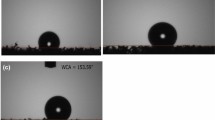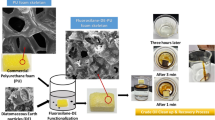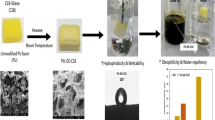Abstract
Polyurethane foam (PUF) has the characteristics of light, loose and polyporous. These characteristics make it play a great role in the adsorption of offshore oil spill. However, the recovery of oil spills in the multi-microbial Marine environment requires not only high adsorption properties of materials, but also efficient antibacterial properties. In this study, we prepared amino acid doped antibacterial polyurethane foam (AA-PUF). Then, polydopamine (PDA) and modified multi-walled carbon nanotubes (MWCNTs) were used to modify the surface of polyurethane, and MWCNTs/PDA@AA-PUF with antibacterial property and excellent oil–water separation effect was prepared successfully. The modified AA-PUF had high absorption rate (23 times of self-weight) and could realize cyclic adsorption while preventing bacterial adhesion. These studies indicated that AA-PUF was modified by PDA and MWCNTs which can be used as an efficient oil–water separation material, and it can prevent the adhesion of bacteria. This special material has great potential for practical application in solving oil–water separation in complex environment.
Graphical Abstract
(a) Flow chart of polyurethane foam modification; (b) Oil–water separation process.











Similar content being viewed by others
Data availability
The date that support the findings of this study are available from the corresponding author upon reasonable request.
References
E. Wolok, J. Barafi, N. Joshi, R. Girimonte, S. Chakraborty, Study of bio-materials for removal of the oil spill. Arab. J. Geosci. 13, 1–11 (2020)
E.M. Hadji, B. Fu, A. Abebe, H.M. Bilal, J. Wang, Sponge-based materials for oil spill cleanups: a review. Front. Chem. Sci. Eng. 14, 749–762 (2020)
A.C. Lewis, J.R. Hopkins, D.C. Carslaw, J.F. Hamilton, B.S. Nelson, G. Stewart, J. Dernie, N. Passant et al., An increasing role for solvent emissions and implications for future measurements of volatile organic compounds. Philos. Trans. Royal Soc. A: Math. Phys. Eng. Sci. (2020). https://doi.org/10.1098/rsta.2019.0328
Z. Mo, R. Cui, B. Yuan, H. Cai, B.C. McDonald, M. Li, J. Zheng, M. Shao, A mass-balance-based emission inventory of non-methane volatile organic compounds (NMVOCs) for solvent use in China. Atmos. Chem. Phys. 21, 13655–13666 (2021)
V. Broje, A.A. Keller, Improved mechanical oil spill recovery using an optimized geometry for the skimmer surface. Environ. Sci. Technol. 40, 7914–7918 (2007)
V. Broje, A.A. Keller, Effect of operational parameters on the recovery rate of an oleophilic drum skimmer. J. Hazard Mater. 148, 136–143 (2007)
E. Barry, A.U. Mane, J.A. Libera, J.W. Elam, S.B. Darling, Advanced oil sorbents using sequential infiltration synthesis. J. Mater. Chem. A. 5, 2929–2935 (2017)
P. Song, M. Wang, J. Di, J. Xiong, S. Zhao, Z. Li, Reusable graphitic carbon nitride nanosheet-based aerogels as sorbents for oils and organic solvents. ACS Appl. Nano Mater. 3, 8176–8181 (2020)
P. Azad, S. Raut, R. Vaish, Candle soot-coated egg carton material for oil water separation and detergent adsorption. B Mater. Sci. 43, 1–6 (2019)
J. Aurell, B.K. Gullett, Aerostat sampling of PCDD/PCDF emissions from the Gulf oil spill in situ burns. Environ. Sci. Technol. 44, 9431–9437 (2010)
B. Wang, W. Liang, Z. Guo, W. Liu, Biomimetic super-lyophobic and super-lyophilic materials applied for oil/water separation: a new strategy beyond nature. Chem. Soc. Rev. 44, 336–361 (2014)
J.L.R.R.J.F. Hobbs, V. Peter, Particle and gas emissions from an in situ burn of crude oil on the ocean. J. Air Waste Manag. Assoc. 46, 251–259 (1996)
S.A. Stout, J.R. Payne, Chemical composition of floating and sunken in-situ burn residues from the deepwater horizon oil spill. Mar. Pollut. Bull. 108, 186–202 (2016)
J. Chen, Y. Zhang, C. Chen, M. Xu, G. Wang, Z. Zeng, L. Wang, Q. Xue, Cellulose foam with superhydrophilicity and high oleophobicity both in air and under water for efficient oil-water emulsion separation. Macromol. Mater. Eng. 302, 1700086 (2017)
R.-J. Shi, T. Wang, J.-Q. Lang, N. Zhou, M.-G. Ma, Multifunctional Cellulose and Cellulose-Based (Nano) Composite Adsorbents. Front. Bioeng. Biotechnol. (2022). https://doi.org/10.3389/fbioe.2022.891034
C.-K. Tsai, C.-Y. Liao, H.P. Wang, Y.-C. Chien, C.-J.G. Jou, Pyrolysis of spill oils adsorbed on zeolites with product oils recycling. Mar Pollut Bull. 57, 895–898 (2008)
S. Koushkbaghi, S. Jamshidifard, A. ZabihiSahebi, A. Abouchenari, M. Darabi, M. Irani, Synthesis of ethyl cellulose/aluminosilicate zeolite nanofibrous membranes for oil–water separation and oil absorption. Cellulose 26, 9787–9801 (2019)
A. Bayat, S.F. Aghamiri, A. Moheb, G.R. Vakili-Nezhaad, Oil spill cleanup from sea water by sorbent materials. Chem Eng Technol. 28, 1525–1528 (2005)
P. Negi, A. Kumar, Biomass-derived activated carbon/epoxy composite as microwave absorbing material. J. Electron. Mater. 51, 2918–2925 (2022)
V.K. Gupta, P.J.M. Carrott, R. Singh, M. Chaudhary, S. Kushwaha, Cellulose: a review as natural, modified and activated carbon adsorbent. Biores. Technol. 216, 1066–1076 (2016)
F. Beshkar, H. Khojasteh, M. Salavati-Niasari, Recyclable magnetic superhydrophobic straw soot foam for highly efficient oil/water separation. J Colloid Interf Sci. 497, 57–65 (2017)
Y. Zhou, J. Wang, M. Sun, W.H. Li, X.T. Hu, Adsorption of CO2 by nitrogen doped corn straw based biochar. Arab. J. Geosci. 14, 1–9 (2021)
Y.P. Patil, B. Gajre, D. Dusane, S. Chavan, S. Mishra, Effect of maleic anhydride treatment on steam and water absorption of wood polymer composites prepared from wheat straw, cane bagasse, and teak wood sawdust using Novolac as matrix. Journal of Applied Polym Sci. 77, 2963–2967 (2000)
P. Król, B. Król, Structures, properties and applications of the polyurethane ionomers. J Mater. 55, 73–87 (2019)
M.W. Terban, R. Dabbous, A.D. Debellis, E. Pöselt, S.J.L. Billinge, Structures of hard phases in thermoplastic polyurethanes. Macromolecules 49, 7350–7358 (2016)
M.W. Terban, K. Seidel, E. Pöselt, M. Malfois, R.-P. Baumann, R. Sander, D. Paulus, B. Hinrichsen et al., Cross-examining polyurethane nanodomain formation and internal structure. Macromolecules 53, 9065–9073 (2020)
X. Zhang, D. Liu, Y. Ma, J. Nie, G. Sui, Super-hydrophobic graphene coated polyurethane (GN@PU) foam with great oil-water separation performance. Appl Surf Sci. 422, 116–124 (2017)
Z. Cui, W. He, J. Liu, W. Wei, L. Jiang, J. Huang, X. Lv, Fabrication of polysiloxane-modified polyurethane foam as low-cost organics/water separation and selective absorption material. Water Sci. Technol. 74, 1936–1945 (2016)
Y. Ozaki, Y. Wang, Two-dimensional near infrared correlation spectroscopy: principle and its applications. J. Near Infrared Spectrosc. 6, 19–31 (1998)
D. Mallinson, A.B. Mullen, D.A. Lamprou, Probing polydopamine adhesion to protein and polymer films: microscopic and spectroscopic evaluation. J. Mater. Sci. 53, 3198–3209 (2017)
X.-Q. Chen, B. Zhang, L. Xie, F. Wang, MWCNTs polyurethane foam with enhanced super-hydrophobicity for selective oil–water separation. Surf. Eng. 36, 651–659 (2020)
P. Aiyetan, K. Narayan, D. Mott, R. Kuchipudi, C. Zeitler, D. Hope, U. Mudunuri, A. Quong, A FAIR principle data model for focused ion beam scanning electron microscopy (FIB-SEM) and the frederick national laboratory data coordinating center. Microsc. Microanal. 25, 1368–1369 (2019)
L. Liang, Y. Xue, Q. Wu, Y. Dong, X. Meng, Self-assembly modification of polyurethane foam for application in oil/water separation. Rsc Adv. 9, 40378–40387 (2019)
Acknowledgments
This work was supported by Sanya Science and Education Innovation Park of Wuhan University of Technology, Science and technology project of Yazhou Bay Science and Technology City Administration Bureau, Sanya (SKJC-2020-01-004), Opening Foundation of Sanya Science and Education Innovation Park of Wuhan University of Technology (2020KF0016), Opening Foundation of Sanya Science and Education Innovation Park of Wuhan University of Technology (2021KF0009), Rizhao Biomedicine and New Materials Research Institute Of Wuhan University of Technology, Technological Innovation Project of Rizhao City (2019CXZX1108), Hubei Shifeng New Material Co., LTD. Thanks for the support provided by the above projects and units.
Funding
This work was supported by Sanya Science and Education Innovation Park of Wuhan University of Technology, Science and technology project of Yazhou Bay Science and Technology City Administration Bureau, Sanya (SKJC-2020–01-004), Opening Foundation of Sanya Science and Education Innovation Park of Wuhan University of Technology (2020KF0016), Opening Foundation of Sanya Science and Education Innovation Park of Wuhan University of Technology (2021KF0009), Rizhao Biomedicine and New Materials Research Institute Of Wuhan University of Technology, Technological Innovation Project of Rizhao City (2019CXZX1108).
Author information
Authors and Affiliations
Contributions
GZ and HS designed research, performed research, analyzed date, and wrote the manuscript. QG, YX and FF collected the date, and analyzed the date. LF designed the study, conceived of the study.
Corresponding author
Ethics declarations
Conflict of interest
The authors declare no conflict of interest.
Additional information
Publisher's Note
Springer Nature remains neutral with regard to jurisdictional claims in published maps and institutional affiliations.
Supplementary Information
Below is the link to the electronic supplementary material.
Rights and permissions
Springer Nature or its licensor (e.g. a society or other partner) holds exclusive rights to this article under a publishing agreement with the author(s) or other rightsholder(s); author self-archiving of the accepted manuscript version of this article is solely governed by the terms of such publishing agreement and applicable law.
About this article
Cite this article
Zhang, G., Sun, H., Gong, Q. et al. Preparation and modification of antibacterial polyurethane foam for oil–water separation. Journal of Materials Research 38, 2701–2712 (2023). https://doi.org/10.1557/s43578-023-00993-z
Received:
Accepted:
Published:
Issue Date:
DOI: https://doi.org/10.1557/s43578-023-00993-z




